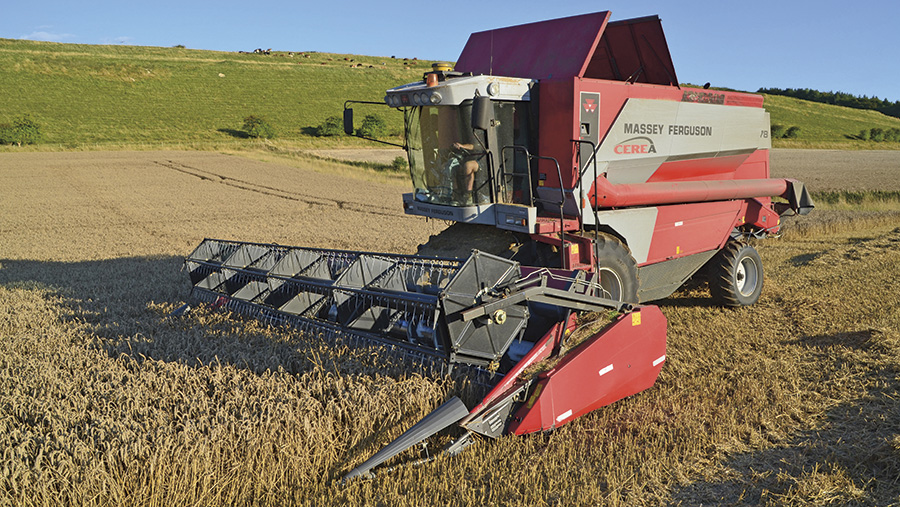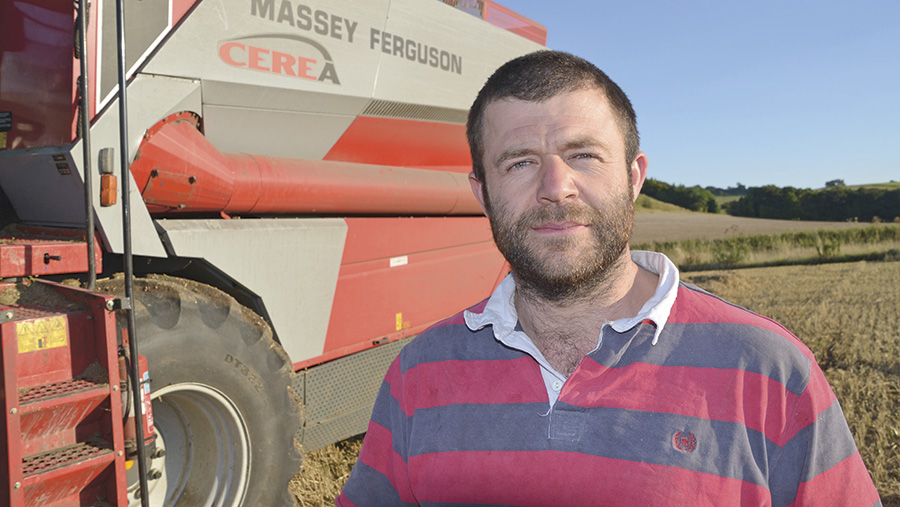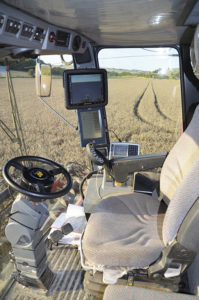Driver’s view: Massey Ferguson Cerea 7278 combine
Trading in the farm’s 15-year-old combine for one that’s both newer and larger capacity was a must for Fyfield Farm.
Until last year a Massey Ferguson 36RS had been responsible for cutting the crops at Fyfield Farm near Marlborough and although it had only done 2,000 drum hours it was beginning to show its age.
With the price tag of a new combine looking daunting, second-hand was the only way to go.
The Massey’s price tag proved irresistible over other brands. Auto-levelling and a high specification meant this is where the best value for money was found.
After some initial teething problems, the younger 7278 chomps through more acres a day than the old machine to take full advantage of narrow Wiltshire weather windows.
No fewer than eight straw-walkers and a huge sieve area make 35t/hour possible.

Massey Ferguson Cerea 7278 combine © Nick Fone
“During harvest 2014 the 36 cost a small fortune in parts and was broken down a lot,” says Mr Warman.
“That meant we didn’t cut crops at their best and so missed out on the premiums we rely on to make our small acreage viable.
“We couldn’t have a repeat performance and so we decided to swap the combine.
“I had only two requirements – it needed to be considerably younger than the old one and I wanted it to have full-body levelling.”

Ian Warman © Nick-Fone
“After a good deal of looking around he settled on another Massey – this time a 2008 Cerea 7278.
“Similar in many ways to the 36RS and built at MF’s now defunct Dronningborg factory in Denmark, with eight straw-walkers the new combine offered significantly more capacity.
See also: Tips for buying a quality used combine on a £40,000 budget
Why a Massey Ferguson Cera?
“Initially, I’d have liked a New Holland but they didn’t really offer a hill-sider of the size we wanted which was a shame given we have decent dealer on the doorstep.
“My next thought was a Lexion Montana but when it came down to a deal, the trade-in offered by our local Claas dealer for the 36 was less than half of any other dealer’s offer.
“On top of that, for the price of a used Montana I could buy two equivalent age Massey or John Deere combines.
“So it then came down to the proximity of dealers – our local MF branch is 15 minutes away while the Deere one is 45 minute drive.
“Lister Wilder had a pair of 7278s in our price range so I went and took a look at them and selected what appeared to be the one in better condition.
“ I do all our own maintenance and repairs so there was a value in having the familiarity of another Dronningborg-built machine.
“The other factor for having a Massey was the Powerflow header – it draws difficult crop in, presents it right to the feeder housing and there isn’t the hassle of fitting rape extensions.
“Going to an eight-walker machine took us massively overcapacity but it now means our contract combining acreage doesn’t impact on cutting crops on the home farm.”
Likes and gripes
Likes
- Good value – a lot of combine for the money
- AutoLevel – full body leveling minimises losses on slopes
- Sophistication – all adjustments made electronically from the cab
- Straw chopper – improved chop and spread
Gripes
- Reliability – not the best build quality
- Physically massive – big, wide eight-walker body
- Cheap hoses – single-braided hydraulic pipes have begun to fail
- Reel flex – fully down, reel can bounce and break knife sections
What is it capable of?
“In good, standing wheat the 7278 can sensibly do 30t/hour and it’s not working hard.
“We can push that to more than 35t but you then see walker losses start to climb.
“Being a wide-bodied machine there’s a huge cleaning area so sieve losses are never a problem and having the AutoLevel model means we don’t have to slow down going across side-slopes.”
Is the chopper any good?
“The chopper is a huge improvement over the previous one.
“It’s still a Rekord unit but the spread is so much better and actually covers the full cut-width.
“That’s now very important here as we’ve moved to chopping everything bar our barley straw in an effort to maintain soil organic matter and improve fertility.”
Cab and controls?
“It’s got the same cab as the 36 which felt very advanced for a late 1990s combine, but now it seems a little bit dated.
“It’s not particularly luxurious but is very functional – the switchgear is a simple and easy to replace and every single setting can be made electronically through the Datavision terminal.
“You can even adjust left and right sections of the sieves which is great in principle but accessing the settings menus is awkward so you’re less inclined to bother in work.
“The other let down is the joystick – it’s less intuitive than the old machine which had mini thumb-sticks for the various functions.

The combine’s cab was described as functional © Nick Fone
“Now it’s all identical buttons which you have to double-check each time because they’re less easy to identify by touch.”
What did it cost?
“On 920 drum hours and 1,120 engine hours it was £67,500 less a £20,000 trade-in for the old machine.
“That was approximately half the price of the equivalent age Lexion Montanas I had looked at.”
Is it reliable?
“The first 80ha last season were a disaster. Lister Wilder told us the machine had been given a full winter service meaning it was harvest ready.
“So it was disappointing there were so many failures.
“The list of failures was big.
“The header auger clutch was badly worn, the trace elevator chains broke and the retractable finger bushes needed replacing.
Vital statistics
- 2008 model on 1,320 engine hours
- Eight straw-walkers
- 413hp Sisu engine
- 7.5m (25ft) header
- 9,500-litre grain tank
- AutoLevel body levelling
- Made in Denmark
“On top of that, the chaff-spreader pump didn’t function from the start and the list of problems just seemed to rumble on.
“However once I had got the maintenance in hand myself the reliability improved massively and, to be fair to Listers, their parts back-up has been very good.
“I’m not under any illusions about the reliability reputation of MF combines but we took a view on it given the value for money they offer second-hand.”
Would you have another?
“I would hope the 7278 will do another 10 years here but when we’re next looking I’d like to be able to consider all the options.
“However, Claas isn’t likely to be in the frame as they’ve just closed their local depot.
“If John Deere and Massey continue to offer the best value for money, they’re likely to be the front-runners.”
Farm facts
Fyfield Farm, near Marlborough, Wilts
- Farmed area 120ha plus 80ha of contract combining
- Cropping Winter wheat, spring barley, spring beans, oilseed rape, conservation cover crops and permanent pasture
- Soils Predominantly chalky silt clay loams
Machinery
- Tractors Case IH MX170 and MF 6499
- Loader JCB 530-70
- Combine MF Cerea 7278 with 7.5m (25ft) Powerflow header
- Sprayer 4,000-litre Knight trailed with 24m booms
- Drills 6m John Deere 750A and 4m Kverneland power-harrow combination
